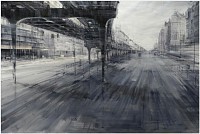BIOGRAPHY

ALESSANDRO PAPETTI
(b. 1958, Milan, Italy)
Alessandro Papetti was born in Milan in 1958 and started exhibiting in solo and group exhibitions from 1988 onwards. For the first two years of his career, he concentrated on the theme of Ritratti visti dall’alto, a cycle to which Giovanni Testori devoted an article in Il Corriere della Sera in 1989. This wide-angle view of real life was followed by a cycle of paintings created between 1990 and 1992 entitled Reperti (Relics), in which his attention was more focused on detail and on the marks left by time in factory workshops and interiors.
His studies of what he calls ‘industrial archaeology’ would become more in-depth in the years that followed – as demonstrated, for example, in the 1996 exhibition at the Musei Civici in Villa Manzoni, Lecco.
From 1992, Papetti began participating in exhibitions in public spaces and various art fairs in Europe and the United States. In 1995, he started working between Milan and Paris. That same year, he met writer and biographer James Lord, who dedicated an important critical text to him in 1996. During this period, his portraits and depictions of interiors ran parallel with his studies on the nude – which became the subject of the show La forza dell’immagine, la pittura del realismo in Europa, held at the Gropius Bau Museum in Berlin in 1996, and Sui Generis at PAC in Milan, commissioned by Alessandro Riva.
These studies led him to create the paintings in the cycle Acqua (Water) from 1998 onwards, exhibited for the first time at the Studio Forni in Milan in 1999. Here we find bodies suspended motionless in swimming pools, or – as in the series Il bagno di notte (Night-swimming) – caught just before plunging into the blackness of a sea illuminated by a livid, lunar light. These were some of his first images of figures in outdoor settings.
The result of his new pictorial cycle and of the preceding cycle dedicated to industrial environments was the production of Cantieri navali (Shipyards). In the 2002 show dedicated to this theme, Papetti exhibited the landscape of industrial ports, dry docks and gigantic hulls, together with a cycle of huge faceless nudes. It was an expression of the bodies of ships and humans in all their epic scale and fragility.
2003 and 2004 saw Papetti being invited to take part in several museum exhibitions – including one dedicated to Giovanni Testori at the Palazzo Reale in Milan and another entitled La ricerca dell’identità, commissioned by Vittorio Sgarbi and showing in various different public spaces through Italy.
In 2005, Papetti took part in the exhibitions Miracolo a Milano at Palazzo della Ragione and Il paesaggio italiano contemporaneo at Palazzo Ducale in Gubbio. In the same year, the Fondazione Mudima dedicated a retrospective of his work entitled Il disagio della pittura, in which Papetti exhibited the last twenty years of his oeuvre in a selection of paintings ranging from Testorian figures viewed from above to the paintings on the theme of the Città. This was followed by a show six months later entitled Il ventre della città.
In all these years, Papetti has regularly reworked themes and subject matter, exploring urban scenes on the streets, interior and exterior spaces – and the spill-over between public and private spaces. His interest in industrial archaeology led to a series of paintings dedicated to the former Renault factory, exhibited in 2007 at the Musée des Années 30 in Paris, in a show entitled Île Seguin. In 2007, Vittorio Sgarbi also invited Papetti to take part in the show Arte italiana. 1968-2007 Pittura at the Palazzo Reale in Milan. This year also saw him take part in the exhibition La nuova figurazione italiana. To be continued... at the Fabbrica Borroni in Bollate.
In 2009, Papetti participated in the show No Landscape - La sparizione del paesaggio, held at the Fondazione Bandera in Busto Arsizio and the group exhibition L’anima dell’acqua at the Ca’ d’Oro in Venice. In the same year, he also exhibited his cycle of circular paintings dedicated to water, the forest and the wind, in the exhibition Il ciclo del tempo at Palazzo Reale in Milan, curated by Achille Bonito Oliva. In these works (each painting is eight meters in diameter), the viewer’s sense of perspective is disorientated by the format and scale of the paintings.
In 2010, Papetti had three solo exhibitions – in Tokyo, Vancouver and the Palladio’s Villa Manin (Italy) – and in the following year he attended the Biennale di Venezia at the Italian Pavillon, curated by Vittorio Sgarbi, and the Cuban Pavillo. Still devoted to industrial archaeology, his 2012 show entitled Factories of Utopia was held at the Moscow Museum of Architecture – Muar. At the end of the same year, his solo exhibition Autobiografia della pittura was held at the Contini Art Gallery, with a critical essay by Luca Beatrice appearing in the catalogue.
During the Spring of 2013, several significant solo exhibitions took place outside of Italy: including at the Everard Read Gallery in Johannesburg; in Berlin at the Halle am Wasser @ Hamburger Bahnhof, curated by Frederik Foert and Gianluca Ranzi; and in Paris at the Mairie du Ier arrondissement.
At the beginning of 2014, Papetti participated at the exhibition Doppio sogno, curated by Luca Beatrice and Arnaldo Colasanti, held in Palazzo Chiablese in Turin. In June, he opened a show at the Palazzo della Penna of Perugia, entitled La pelle attraveso and curated by Luca Beatrice.
Over the last fifteen years, Papetti has exhibited his works at major art fairs and collaborated with several foreign galleries. He is one of Italy’s most innovative and exciting contemporary painters.



